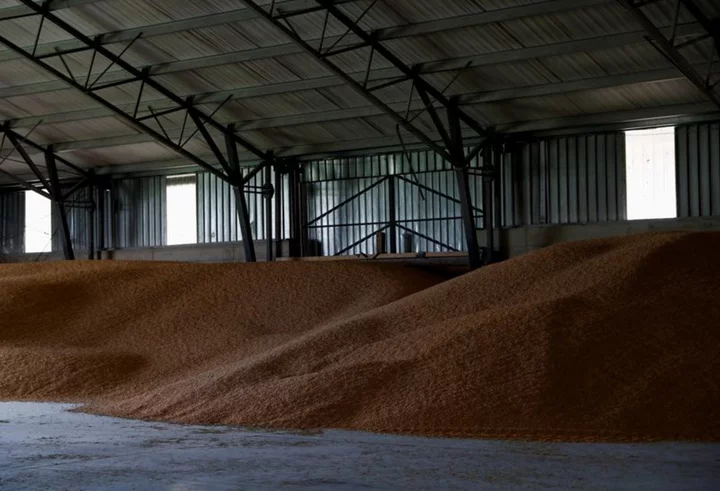By Anna Koper, Gergely Szakacs and Luiza Ilie
WARSAW When global grain prices started falling last year after a spike in the first months of the war in Ukraine, Poland's then agriculture minister urged farmers to hang onto their harvests in the hope of a rebound and better returns.
The bet backfired badly for some.
Nearly a year later, Polish farmer Artur Konarski still has about 150 tonnes of grain stuck in storage and he says some of his competitors in the European Union's third-biggest wheat producer have even bigger stocks of crops languishing in silos.
Farmers in Poland and other eastern European countries who held out for higher prices have been hit by a perfect storm.
A jump in exports from Brazil and Russia helped to drive global grain prices lower while the EU opened its borders to tariff-free Ukrainian grain imports in a show of solidarity after Russia blocked the country's Black Sea ports.
While the EU's aim was to give Ukrainian farmers an outlet to ship grain and oilseeds to their traditional markets in Africa, the Middle East and Asia - and help ease a global food crisis - much has remained in Eastern Europe.
With a dearth of local produce in Poland, millers and livestock producers desperate for grain turned instead to a flood of imports from Ukraine ferried into the EU by trucks and trains, grain traders and farmers said.
Eastern Europe's governments have pointed the finger of blame for its farmers' woes at Ukraine, but Adrian Wawrzyniak, spokesman for the Polish Trade Union of Individual Farmers, said some of the region's troubles were self-inflicted because farmers, encouraged by politicians, had hoarded crops.
"This led to lower sales during the harvest and storage of cereals by farmers, the consequence of which they are paying for today with a reduction in income from the sale of cereals," he said.
Local buyers had plenty of alternative supplies.
After opening its borders to Ukrainian grain, Poland imported 2.08 million tonnes of maize and 579,315 tonnes of wheat last year, up from just 6,269 tonnes of maize and 3,033 tonnes of wheat in 2021.
"Since the farmers did not sell, (feed and flour mills) just bought Ukrainian grain to have raw materials for current production," said a Polish grain trader who declined to be named because he is not authorised to talk to the media.
UNILATERAL IMPORT BANS
Despite being a staunch ally of Ukraine, Poland banned Ukrainian grain imports in April in response to furious complaints from farmers in its rural heartlands where support for the ruling Law and Justice (PiS) Party is strong.
Hungary, Slovakia and Bulgaria quickly followed Poland's lead, sparking a row with Brussels over trade policy and demands for compensation for their angry farmers from EU funds.
The unilateral import bans were lifted last week but only after the European Commission agreed to block sales of Ukrainian wheat, maize, rapeseed and sunflower seed within those four member states and Romania from May 2 until June 5.
But the issue is unlikely to go away.
Negotiations with Russia to extend a deal allowing some grain exports through three of Ukraine's Black Sea ports to alleviate a global food crisis are hanging in the balance.
If the grain corridor due to expire this month were to collapse, Ukrainian farmers would have little option but to send all their grain exports through eastern Europe.
Grain traders said the price paid for Ukraine's grain was in line with European market levels, but they have fallen well below the prices sought by many farmers in eastern Europe.
European wheat prices hit post-harvest highs in October 2022 of more than 350 euros a tonne but since then prices have dropped to pre-invasion levels of about 235 euros.
That's also a far cry from the peak of 450 euros a tonne for European wheat in the immediate aftermath of Russia's attack.
"The farmers blame the government for low prices due to Ukrainian imports, which is not really true," the Polish grain trader said.
Ukraine's farmers, meanwhile, said they receive far less than the market price, as about 100 euros a tonne is deducted to cover transport to eastern Europe, far higher than the costs of shipping their grain out of Black Sea ports.
The EU restrictions on grain imports have also worsened an already bleak outlook for agriculture in Ukraine, which was the world's third-largest grain exporter before the war with Russia.
Ukrainian farmers say they have had to sharply reduce the amount of crops such as maize and wheat they plant due to the difficulty and high cost of getting supplies out of the country.
RUSH FOR UKRAINIAN IMPORTS
The influx of Ukrainian grain into eastern Europe has also hurt the ability of its EU neighbours to export their own crops as there is a shortage of available trucks and railwagons.
In Romania, farmers complain that local mills and processors were not interested in their wheat and maize, saying trucks of Ukrainian grain were lining up at their gates. Farmers said they had struggled to find lorries to move their own goods, with the cost of logistics up 70% from before the war.
"Across the EU and the supply chain, small sellers, traders, food processors have benefited," said Cezar Gheorghe at consultancy AGRIColumn. "Romanian farmers have systematically missed windows to sell their grain, beginning in May 2022."
Since the conflict, began about 17 million tonnes of major agricultural products have left Ukraine by road, railways as well as barges on the Danube river, data issued by Ukraine's farm ministry shows.
All the grain, representing about 38% of Ukraine's exports, went into the eastern European Union as Ukraine's borders with Russia and Belarus have been closed.
"The desire of local producers to hold on to their crop in anticipation of higher prices created a shortage on the local market, so consumers rushed to buy the Ukrainian grain available at the time," the Ukraine grain traders union UGA said.
Another 28 million tonnes of Ukrainian agricultural products have been exported from its Black Sea ports through the safe corridor, U.N. data shows.
POOR HARVESTS AND MOULD
In Hungary, the influx of grain from Ukraine has not caused the same problems with oversupply as in Poland and Bulgaria, due to a disastrous maize harvest last summer.
"Poland has been the most exposed because it had decent harvests itself. Hungary had such a bad maize harvest that it would have had to import maize, whether there was war in Ukraine or not," said Benoit Fayaud, an analyst with Strategie Grains.
The consultancy forecasts maize stocks in Hungary will actually fall this season despite a rise in imports.
Pannonia Bio, a biorefinery in Hungary, said it had to buy maize from Ukraine, Slovakia, Poland and Romania to keep its business running, but even then it was forced to curb output because of the fall in the local harvest.
Hungarian farmer Andras Pasztor said his company raked in just 15% of its average maize crop from fields near Hungary's eastern border with Ukraine and about half of that, some 2,000 tonnes, is still waiting to be sold.
The contamination of some stocks with the toxic by-product of a mould that flourishes in dry conditions has also hampered Hungarian crop sales, with some local buyers turning to alternatives because of quality concerns, farmers said.
However, even the untainted maize has been difficult to sell. Ukraine exported 1.7 million tonnes of maize to Hungary in the year following Russia's invasion, up from just 30,000 tonnes before the war, customs data shows.
"Traders were not looking for (Hungarian maize) because they were uncertain about the quality, and the Hungarian produce is more expensive," said Pasztor. "Given a cheaper alternative, they went for the more cost-effective option."
($1 = 0.9099 euros)
(Anna Koper reported from Warsaw, Gergely Szakacs from TIMAR, Hungary, Luiza Ilie from Bucharest and Nigel Hunt from London; Additional reporting by Gus Trompiz in Paris and Marek Stzelecki in Warsaw; Editing by David Clarke)









